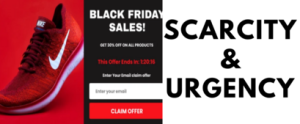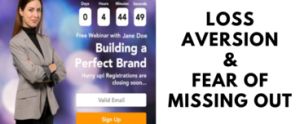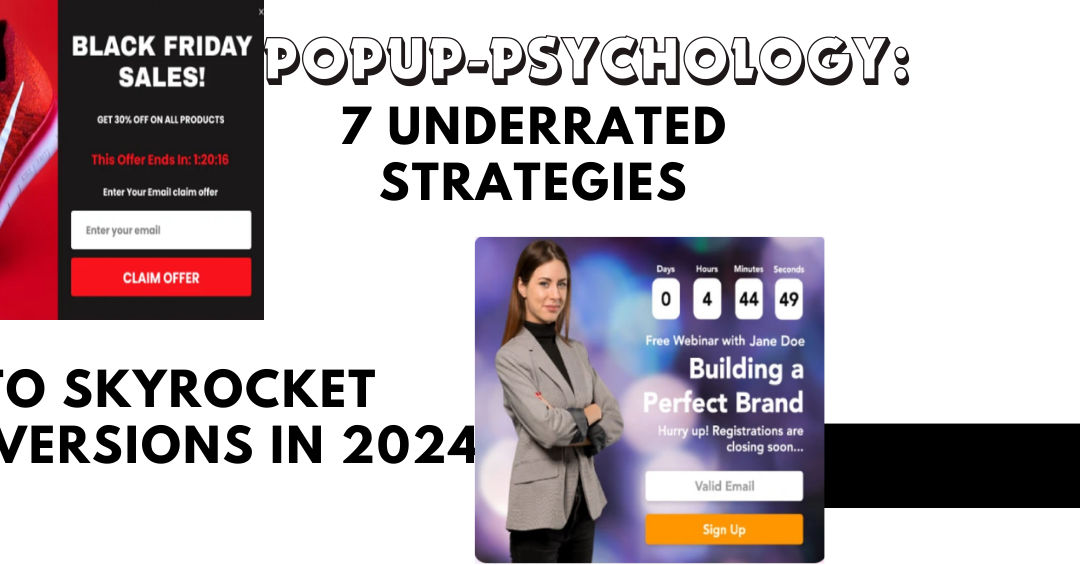Popups are smart inventions by bloggers to increase interactions on their website(s). Most websites are able to convert their visitors using these popups. With the increase in technology invention and human intelligence, popups will likely become more personal in 2024.
Imagine seeing a popup that knows you so well to understand what you like and when you like it. In 2024, popups will less likely be annoying interruptions, they would rather be fun, friendly, and clever helpers that will make your online experience easier and way better.
The major frustration that e-commerce owners face with low conversion rates is not knowing the secret of making online window shoppers click ‘buy’ while addressing their concerns.
The continuous increase in competition makes it more difficult for these e-commerce owners to stand out.
For e-commerce owners, giving seamless experiences on demand, staying ahead of market shifts and consistently adapting to the ever-changing online trends and technology may increase the frustration that they already face.
Consequently, if e-commerce owners are to overcome this frustration, they must understand the concept of pop-up psychology and its maximum impact on conversions. Popups have the potential to skyrocket conversions if optimized properly.
What these e-commerce owners should understand is that where popups are more timed and crafted to solve specific user needs it can very well intensify engagement.
E-commerce owners should understand that their customers are humans, hence tailoring content to evoke their emotions, creating a sense of urgency, and offering exclusive deals are the key ingredients to having a conversion.
If you are an e-commerce owner and you are reading this, you will not want to miss out on the value in this article. We will be discussing in detail 7 underrated triggers that can skyrocket conversions in 2024.
Read till the end and change your e-commerce experience forever!
7 Underrated Strategies to Skyrocket Conversions in 2024
Here are seven (7) strategies that have been underrated over time but can skyrocket your conversions
- Scarcity and Urgency
- Personalization and Relevance
- Social Proof and Trust
- Curiosity and Intrigue
- Gamification and Interaction
- Loss Aversion and FOMO
- Psychological Optimization
1. Scarcity and Urgency
Leveraging scarcity and urgency will always remain pivotal in propelling conversions in 2024. When your customers feel that your products are in abundance, they will delay in making up their minds.
However, if your popup alerts them of the limited availability of a product, it will trigger in them what is known as FOMO (Fear of missing out), and they will be compelled to act swiftly.

It doesn’t end there; your popups must continuously create a sense of urgency. This taps into your users innate desire for immediate gratification and will further prompt them to make quick decisions.
Sense of urgency can be created through countdowns, exclusive offers, and or limited stock notifications. With the decrease in attention span in this digital era, this approach becomes pivotal.
Furthermore, this approach does not only quicken your users’ decision-making process, but it also gives them a sense of heightened value. The exit intent trigger can be used to create scarcity and urgency.
Where a customer is about to leave your product page, and a popup appears making them an offer of 50% if they are the first five customers to purchase the remaining product(s) in less than an hour.
2. Personalization and Relevance
One thing you should aim to do as an e-commerce owner in 2024 is understanding your users’ individual preferences and tailoring experiences in a way that resonates deeply with users.
Your users want to feel important to you. They don’t want to feel like you are just coming for their money and that you don’t really care about them.
The aim is to make your customers relevant, and to do that you have to present products, information, and offers that align with their interests.
Ability to make your customers feel relevant will enhance engagement, and foster trust and loyalty. This is because streamlining the customer’s journey using this tailored approach will also elevate the overall shopping experience.
Two best-suited strategies to determine what is relevant to or preferred by your customers are Time Spent on Site/Specific Page and Geo-Targeted Popup Trigger.
Here the popups are triggered by how much time your customer has spent on a particular product page or your customer’s location.
For instance, if your customer spends a lot of time on a page that sells lingerie, a popup can appear showing them the newest stock and giving them discounted sales offers.
Continuously, a popup can be customized to detect the customer’s location and give them offers of exclusive deals and discounts on local products in their region and in their local language.
3. Social Proof and Trust
It is in human nature to rely on the experiences and opinions of others to make their decisions. As a smart business owner, you should understand that users gravitate towards what others endorse.
Hence, if you want to leverage that, you must showcase testimonials, positive reviews, social media endorsements, and user-generated contents.
This will help you win the trust of your visitors. To further establish trust, you must be transparent in your communication and authentic in your interactions.
The best proper trigger that captures social proof and trust is the Product Page Scroll Depth. What this trigger does is that it differentiates casual browsers from customers that have genuine interest.
Hence, when a customer scrolls to the middle or end of the product page, the popup is triggered. The popup will then contain reviews and testimonies of previously satisfied customers.
This helps indecisive customers to make a decision by building their trust and encouraging them to make a purchase.
4. Curiosity and Intrigue
Smart business owners that want to skyrocket conversions in 2024 should capitalize on crafting marketing strategies that will ignite a sense of wonder and fascination in their users.
This will draw the users in and pique their curiosity in a way that will compel them to explore further.
Some methods to pique the user’s curiosity include: Teaser campaigns, Mystery offers, Interactive content, Intriguing visuals, and Captivating storytelling.
If you are able to tap into the innate human desire to uncover the unknown and maintain an element of mystery and surprise, you will create memorable experiences in the minds of consumers propelling them to convert.
The aim is to ensure that your users are not just passive observers or window shoppers but active participants that will promote the brand experience.
This popup should be triggered when a customer is curious or intrigued about a product. The best triggers for this are the Product Page Scroll Depth and the Time Spent on Site/Specific Page.
This is because the popup is triggered when the customer shows a certain amount of curiosity or intrigue on a product page.
5. Gamification and Interaction
Another underrated trigger that most e-commerce owners ignore is the dynamic strategy of combining entertainment and commerce.
If you want to skyrocket your conversions in 2024, you may want to consider turning to game-like elements.
Instead of filling your popups with mundane tasks and leaving conversion to chance, you can turn it into engaging challenges that will encourage active participation.
Some of these engaging challenges can be through incorporating rewards, interactive content, badges, quizzes or anything else that will create a sense of enjoyment, fun and accomplishments in the users.
This approach will cultivate lasting connections, drive active participation and transform users into enthusiastic participants.
The best trigger for this is the Referral Popup Trigger. This challenges the customer to refer another person to buy a product in exchange of a free product, an incentive or a discount.
6. Loss Aversion and FOMO
Loss aversion refers to the tendency to fear losing more than gaining while FOMO simply stands for Fear of Missing Out.
In 2024, e-commerce owners should target how to strategically drive visitors to action by highlighting potential losses.
E-commerce owners should also be quick to introduce urgency-inducing tactics such as exclusive deals and limited-time offers.

These tactics will compel the visitors to take swift action to avoid missing out on opportunities.
Where customers perceive a product to be valuable and scarce, their desire to secure the perceived gains and avoid losses will be stirred which will force them to seize the moment and convert.
The trigger e-commerce owners should focus on using is the exit-intent trigger. If they perceive that a customer is about to leave the product page, the popup will be triggered.
The popup will contain irresistible offers with a time limit such that if the customer doesn’t make a purchase within the time allotted, he/she will miss out on the offer.
7. Psychological Optimization
This trigger focuses on making e-commerce owners understand their customers’ behavior and psychology, and to tailor their strategies to align with those human motivations.
The aim of psychological optimization is to create a seamless connection between users and brands which will enable the brands to fulfill user needs ultimately skyrocketing conversions.
This connection can be built through analyzing user data, adjusting content, timing and presentation using advanced algorithms to resonate with individual preferences.
With the help of A/B testing, the right trigger can be determined. For instance, where two sites with similar contents but different designs are put up, the website that the customers spend more time on will then trigger the popup.
In essence, the Time Spent on Site/Specific Page is the right trigger to use for this. When a customer has spent a reasonable amount on a product page, it will then trigger the popup.
To Wrap This Up,
You understand now that pop-up psychology is a powerful tool for fostering meaningful interactions from casual browsing.
You will also understand that business owners need to understand user behavior to effectively time popups and offer personalized contents in a way that resonates with individuals.
Popups are powerful enough to tap into human psychology and give strategic nudges that will guide users towards conversion.
These nudges can come through scarcity, urgency, social proof, and addressing their needs and preferences at the right moment.
What are you waiting for? Do not delay further, this is a good time to immediately begin implementing these triggers in your own popups.
Frequently Asked Questions
- Will these strategies increase my website’s opt-in rates?
Yes, of course. Strategies such as personalized content, gamification, and scarcity can create engaging experiences that users find valuable and organically boost opt-in rates.
- Is it possible to prevent pop-ups from annoying my website visitors? If it is, how can I achieve that?
Yes it is very possible. However, you must note that timing is of the essence. Ensure you use these pop-ups sparingly when visitors have engaged with your content or are about to leave. The aim is to be non-intrusive and to provide value rather than interruption.
- Will gamification work for all types of products/services, and how can I utilize it without making it overly complicated?
Yes, gamification works for all types of products/services. The main aim is to use easy-to-understand games that align with your brand and product and tailor the elements to suit your audience. Ensure to keep it simple, fun and enjoyable.
- Which industries specifically are these strategies more effective?
These strategies, especially urgency and social proof may be extremely effective in competitive markets, e-commerce, and service-oriented businesses.

